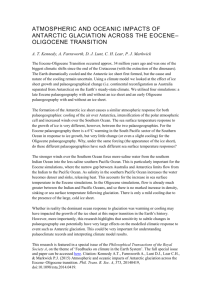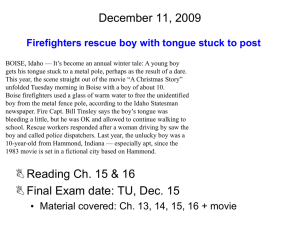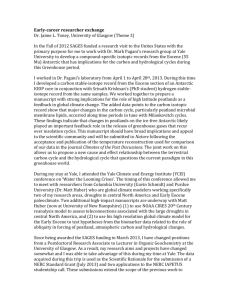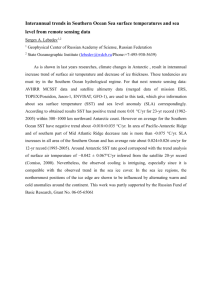Geologists have long recognized (e.g., Lyell,
advertisement
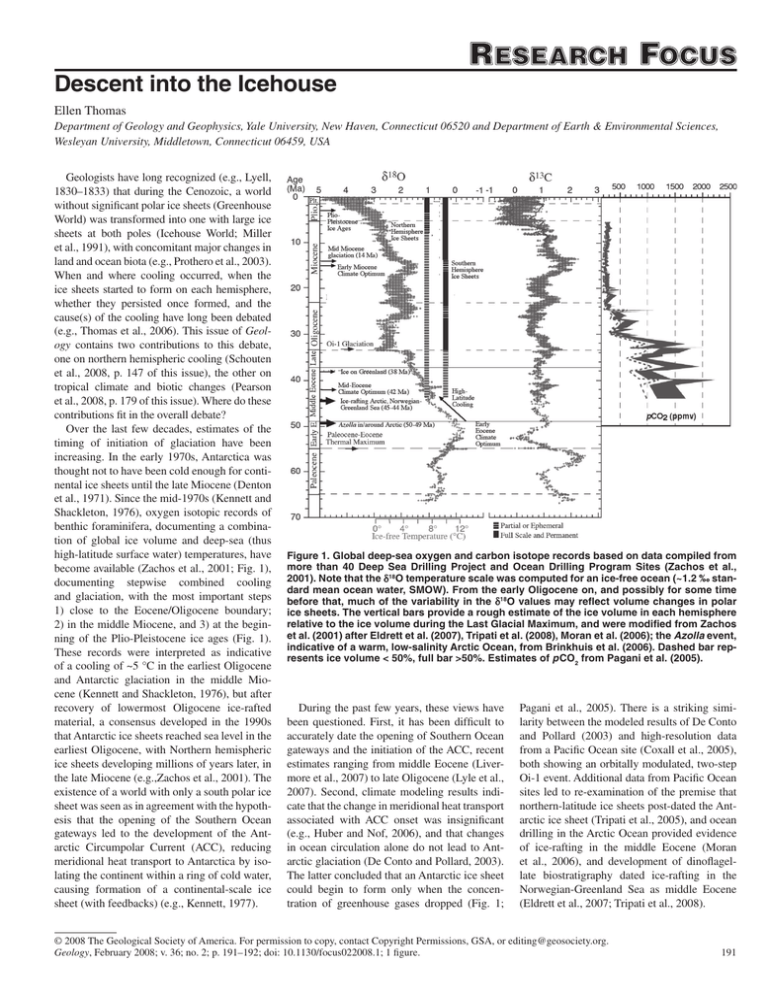
Descent into the Icehouse Ellen Thomas Department of Geology and Geophysics, Yale University, New Haven, Connecticut 06520 and Department of Earth & Environmental Sciences, Wesleyan University, Middletown, Connecticut 06459, USA Geologists have long recognized (e.g., Lyell, 1830–1833) that during the Cenozoic, a world without significant polar ice sheets (Greenhouse World) was transformed into one with large ice sheets at both poles (Icehouse World; Miller et al., 1991), with concomitant major changes in land and ocean biota (e.g., Prothero et al., 2003). When and where cooling occurred, when the ice sheets started to form on each hemisphere, whether they persisted once formed, and the cause(s) of the cooling have long been debated (e.g., Thomas et al., 2006). This issue of Geology contains two contributions to this debate, one on northern hemispheric cooling (Schouten et al., 2008, p. 147 of this issue), the other on tropical climate and biotic changes (Pearson et al., 2008, p. 179 of this issue). Where do these contributions fit in the overall debate? Over the last few decades, estimates of the timing of initiation of glaciation have been increasing. In the early 1970s, Antarctica was thought not to have been cold enough for continental ice sheets until the late Miocene (Denton et al., 1971). Since the mid-1970s (Kennett and Shackleton, 1976), oxygen isotopic records of benthic foraminifera, documenting a combination of global ice volume and deep-sea (thus high-latitude surface water) temperatures, have become available (Zachos et al., 2001; Fig. 1), documenting stepwise combined cooling and glaciation, with the most important steps 1) close to the Eocene/Oligocene boundary; 2) in the middle Miocene, and 3) at the beginning of the Plio-Pleistocene ice ages (Fig. 1). These records were interpreted as indicative of a cooling of ~5 °C in the earliest Oligocene and Antarctic glaciation in the middle Miocene (Kennett and Shackleton, 1976), but after recovery of lowermost Oligocene ice-rafted material, a consensus developed in the 1990s that Antarctic ice sheets reached sea level in the earliest Oligocene, with Northern hemispheric ice sheets developing millions of years later, in the late Miocene (e.g.,Zachos et al., 2001). The existence of a world with only a south polar ice sheet was seen as in agreement with the hypothesis that the opening of the Southern Ocean gateways led to the development of the Antarctic Circumpolar Current (ACC), reducing meridional heat transport to Antarctica by isolating the continent within a ring of cold water, causing formation of a continental-scale ice sheet (with feedbacks) (e.g., Kennett, 1977). Figure 1. Global deep-sea oxygen and carbon isotope records based on data compiled from more than 40 Deep Sea Drilling Project and Ocean Drilling Program Sites (Zachos et al., 2001). Note that the δ18O temperature scale was computed for an ice-free ocean (~1.2 ‰ standard mean ocean water, SMOW). From the early Oligocene on, and possibly for some time before that, much of the variability in the δ18O values may reflect volume changes in polar ice sheets. The vertical bars provide a rough estimate of the ice volume in each hemisphere relative to the ice volume during the Last Glacial Maximum, and were modified from Zachos et al. (2001) after Eldrett et al. (2007), Tripati et al. (2008), Moran et al. (2006); the Azolla event, indicative of a warm, low-salinity Arctic Ocean, from Brinkhuis et al. (2006). Dashed bar represents ice volume < 50%, full bar >50%. Estimates of pCO2 from Pagani et al. (2005). During the past few years, these views have been questioned. First, it has been difficult to accurately date the opening of Southern Ocean gateways and the initiation of the ACC, recent estimates ranging from middle Eocene (Livermore et al., 2007) to late Oligocene (Lyle et al., 2007). Second, climate modeling results indicate that the change in meridional heat transport associated with ACC onset was insignificant (e.g., Huber and Nof, 2006), and that changes in ocean circulation alone do not lead to Antarctic glaciation (De Conto and Pollard, 2003). The latter concluded that an Antarctic ice sheet could begin to form only when the concentration of greenhouse gases dropped (Fig. 1; Pagani et al., 2005). There is a striking similarity between the modeled results of De Conto and Pollard (2003) and high-resolution data from a Pacific Ocean site (Coxall et al., 2005), both showing an orbitally modulated, two-step Oi-1 event. Additional data from Pacific Ocean sites led to re-examination of the premise that northern-latitude ice sheets post-dated the Antarctic ice sheet (Tripati et al., 2005), and ocean drilling in the Arctic Ocean provided evidence of ice-rafting in the middle Eocene (Moran et al., 2006), and development of dinoflagellate biostratigraphy dated ice-rafting in the Norwegian-Greenland Sea as middle Eocene (Eldrett et al., 2007; Tripati et al., 2008). © 2008 The Geological Society of America. For permission to copy, contact Copyright Permissions, GSA, or editing@geosociety.org. GEOLOGY, February 2008 Geology, February 2008; v. 36; no. 2; p. 191–192; doi: 10.1130/focus022008.1; 1 figure. 191 Schouten et al. (p. 147 in this issue) present a new biomarker proxy for land temperatures, by using organic compounds from soil bacteria in the same cores in which middle Eocene ice rafting was recognized (Eldrett et al., 2007), thus providing a novel approach to estimate temperatures on land. The authors arrive at a mean annual temperature of 13–15 °C in the middle to late Eocene, declining by ~5 °C into the earliest Oligocene, similar to megafossil- and isotopederived temperatures for coeval sections in the southern hemisphere (14–15 °C for the middle Eocene, declining to ~10 °C by the end of the Eocene; Dutton et al., 2002; Poole et al., 2005). As Schouten et al. point out, such temperatures might appear high for an environment where we observe ice rafting, but could represent summer rather than annual temperatures. The article by Pearson et al. (p. 179 in this issue) presents data from Tanzanian sections, a veritable treasure trove of beautifully preserved fossil material. Pearson et al. (2007) documented the tropics remained warm until the end of the Eocene, and that long-term middle Eocene cooling as seen in the deep-sea record (Fig. 1) is limited to high latitudes. Their article in this issue confirms the two-step nature of Oi-1, and suggests that only part of this event reflects ice-volume increase. Interpretation of this event as wholly due to ice-volume increase thus probably is incorrect, and benthic Mg/Ca data are not reliable temperature proxies during changes in carbonate ion concentration (Lear et al., 2004). Pearson et al. (this issue) also establish that extinctions in shallow-water organisms, as well as in planktic organisms, started ~0.5 m.y. before the isotope event. In addition, they finally establish that the Eocene/Oligocene boundary, defined by the last occurrence of the planktonic foraminiferal genus Hantkenina, occurs between the two steps of oxygen isotope event Oi-1, so that this isotope event can be used to approximate that boundary. Where does that leave us in the debate on Eocene/Oligocene global cooling? The cooling in the late Eocene and early Oligocene was truly a global event, affecting organisms from high to low latitudes, thus supporting the view that Cenozoic cooling was caused mainly by decreasing CO2 levels in the atmosphere, with subsequent processes such as ice albedo and weathering feedbacks. Proxy records for atmospheric CO2 values, however, show strong variability in the middle-late Eocene (Pearson and Palmer, 2000; Pagani et al., 2005), and no precise 192 correlation with glaciation events (Fig. 1). We need more detailed and accurate proxy records of past CO2 levels, as well as more geographically diverse records of temperature changes across the late Eocene and Oligocene before we can truly understand when, how, and why the Earth descended into the Icehouse state. REFERENCES CITED Brinkhuis, H., and 21 others, and the Expedition 302 scientists, 2006, Episodic fresh surface waters in the Eocene Arctic Ocean: Nature, v. 441, p. 606–609, doi: 10.1038/nature04692. Coxall, H.K., Wilson, P.A., Pälike, H., Lear, C.H., and Backman, J., 2005, Rapid stepwise onset of Antarctic glaciation and deeper calcite compensation depth in the Pacific Ocean: Nature, v. 433, p. 53–57, doi: 10.1038/nature03135. De Conto, R.M., and Pollard, D., 2003, Rapid Cenozoic glaciation of Antarctica induced by declining atmospheric CO2: Nature, v. 421, p. 245–249, doi: 10.1038/nature01290. Denton, G.H., Armstrong, R.L., and Stuiver, M., 1971, The late Cenozoic glacial history of Antarctica, in Turekian, K.K., ed., The Late Cenozoic Glacial Ages: New Haven, Connecticut, Yale University Press, p. 267–306. Dutton, A., Lohmann, K.C., and Zinsmeister, W.J., 2002, Stable isotope and minor element proxies for Eocene climate of Seymour Island, Antarctica: Paleoceanography, v. 17, p. 1016, doi: 10.1029/2000PA000593 Eldrett, J., Harding, I.C., Wilson, P.A., Butler, E., and Roberts, A.P., 2007, Continental ice in Greenland during the Eocene and Oligocene: Nature, v. 446, p. 176–179, doi: 10.1038/nature05591. Huber, M., and Nof, D., 2006, The ocean circulation in the southern hemisphere and its climatic impacts in the Eocene: Palaeogeography, Palaeoclimatology, Palaeoecology, v. 231, p. 9–28, doi: 10.1016/j.palaeo.2005.07.037. Kennett, J.P., 1977, Cenozoic evolution of Antarctic glaciation, the circum-Antarctic Current, and their impact on global paleoceanography: Journal of Geophysical Research, v. 82, p. 3843–3860. Kennett, J.P., and Shackleton, N.J., 1976, Oxygen isotopic evidence for the development of the psychrosphere 38 Myr ago: Nature, v. 260, p. 513–516, doi: 10.1038/260513a0. Lear, C.H., Rosenthal, Y., Coxall, H.K., and Wilson, P.A., 2004, 2004, Late Eocene to early Miocene ice sheet dynamics and the global carbon cycle: Paleoceanography, v. 19, p. PA4015, doi: 10.1029/2004PA001039 Livermore, R., Hillenbrand, C.-D., Meredith, M., and Eagles, G., 2007, Drake Passage and Cenozoic Climate: an open and shut case?: Geochemistry Geophysics Geosystems, v. 8, p. Q01005, doi: 10.1029/2005GC001224 Lyell, C., 1830–1833, Principles of Geology, being an inquiry how far the former changes of the earth’s surface are referable to causes now in operation: London, John Murray, Vols. 1–3. Lyle, M., Gibbs, S., Moore, T.C., and Rea, D.K., 2007, Late Oligocene initiation of the Antarctic Circumpolar Current: Evidence from the South Pacific: Geology, v. 35, p. 691–694, doi: 10.1130/G23806A.1. Miller, K.G., Wright, J., and Fairbanks, R.G., 1991, Unlocking the ice house: Oligocene-Miocene oxygen isotopes, eustasy, and margin erosion: Journal of Geophysical Research, v. 96, p. 6829–6848. Moran, K., et al., 2006, The Cenozoic palaeoenvironment of the Arctic Ocean: Nature, v. 441, p. 601–605, doi: 10.1038/nature04800. Pagani, M., Zachos, J.C., Freeman, K.H., Tipple, B., and Bohaty, S., 2005, Marked decline in atmospheric carbon dioxide concentrations during the Paleogene: Science, v. 309, p. 600–603, doi: 10.1126/science.1110063. Pearson, P.N., and Palmer, M.R., 2000, Atmospheric carbon dioxide concentrations over the past 60 million years: Nature, v. 406, p. 695–699, doi: 10.1038/35021000. Pearson, P.N., van Dongen, B.E., Nicholas, C.J., Pancost, R.D., Schouten, S., Singano, J.M., and Wade, B.S., 2007, Stable warm tropical climate through the Eocene Epoch: Geology, v. 35, p. 211–214, doi: 10.1130/G23175A.1. Pearson, P.N., McMillan, I.K., Wade, B.S., Jones, T.D., Coxall, H.K., Bown, P.R., and Lear, C.H., 2008, Extinction and environmental change across the Eocene-Oligocene boundary in Tanzania: Geology, v. 36, p. 179–182. Poole, I., Cantrill, D., and Utescher, D., 2005, A multi-proxy approach to determine Antarctic terrestrial paleoclimate during the Cretaceous and early Tertiary: Palaeogeography, Palaeoclimatology, Palaeoecology, v. 222, p. 95–121, doi: 10.1016/j.palaeo.2005.03.011 Prothero, D.R., Ivany, L., and Nesbitt, E.A., eds., 2003, From Greenhouse to Icehouse: The marine Eocene-Oligocene transition: New York, Columbia University Press, 541 pp. Schouten, S., Eldrett, J., Greenwood, D.R., Harding, I., Baas, M., and Sinninghe Damsté, J.S., 2008, Onset of long-term cooling of Greenland near the Eocene-Oligocene boundary as revealed by branched tetraether lipids: Geology, v. 36, p. 147–150. Thomas, E., Brinkhuis, H., Huber, M., and Röhl, U., 2006, An ocean view of the early Cenozoic Greenhouse World: Oceanography, v. 19, p. 63–72. Tripati, A., Backman, J., Elderfield, H., and Ferretti, P., 2005, Eocene bipolar glaciation associated with global carbon cycle changes: Nature, v. 436, p. 341–346, doi: 10.1038/nature03874. Tripati, A., Eagle, R.A., Dawber, C.F., Morton, A., Dowdeswell, J.A., Atkinson, K., Bahe, Y., Khadun, E., Shaw, R.M.H., Shorttle, O., and Thanabalasundaran, L., 2008, Evidence for Northern Hemipshere glaciation back to 44 Ma from ice-rafted debris in the Greenland Sea: Earth and Planetary Science Letters, In press., doi: 10.1016/j.epsl.2007.09.045. Zachos, J.C., Pagani, M., Sloan, L., Thomas, E., and Billups, K., 2001, Trends, rhythms, and aberrations in global climate change 65 Ma to present: Science, v. 292, p. 686–693, doi: 10.1126/ science.1059412. Printed in USA GEOLOGY, February 2008
